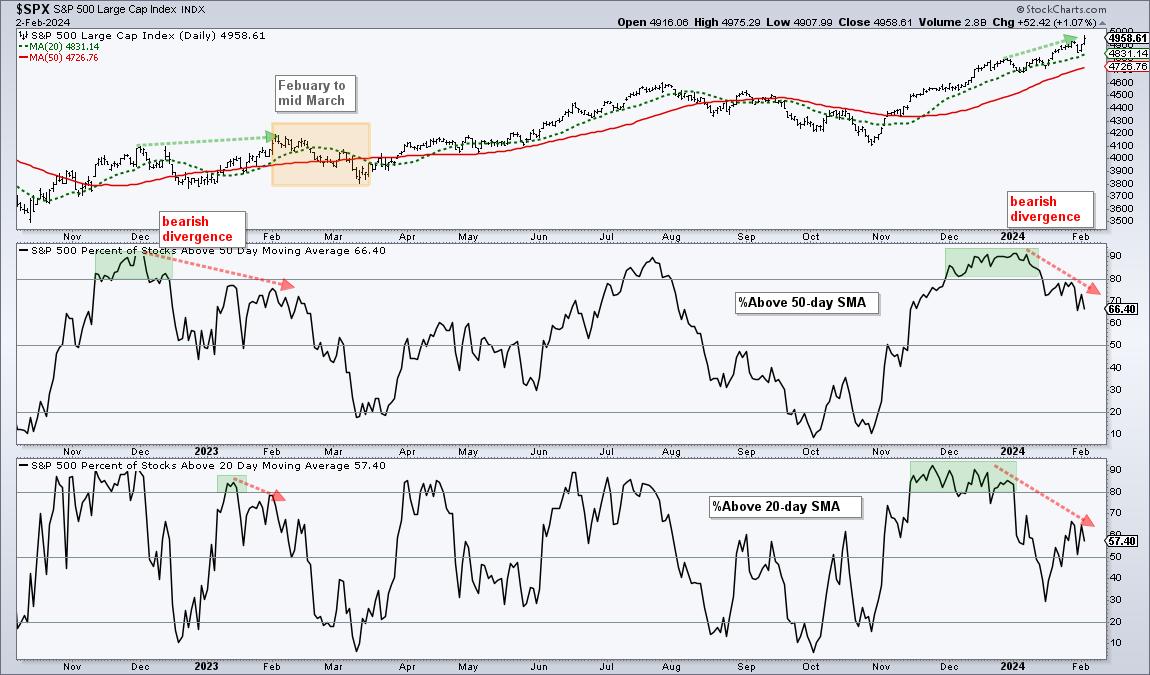 Divergences reflect a disconnect between price and the indicator. A bearish divergence forms when price forges a higher high and the indicator fails to confirm this high. In the case presented below, we have the S&P 500 moving higher and fewer stocks making it back above their 50 and 20 day SMAs. Fewer stocks are participating in the advance from late December to early February. This shows weakness under the surface and this weakness could extend to the index.
Divergences reflect a disconnect between price and the indicator. A bearish divergence forms when price forges a higher high and the indicator fails to confirm this high. In the case presented below, we have the S&P 500 moving higher and fewer stocks making it back above their 50 and 20 day SMAs. Fewer stocks are participating in the advance from late December to early February. This shows weakness under the surface and this weakness could extend to the index.
The chart below shows two breadth indicators based on S&P 500 stocks: the percentage of stocks above their 50 and 20 day SMAs. The S&P 500 hit another new high this week, and remains well above its 50 and 20 day SMAs. These two indicators were keeping pace in December, but stumbled over the last few weeks. Overall, sizable divergences are forming and these could foreshadow a correction or pullback in the stock market.

The first indicator window shows SPX %Above 50-day SMA moving above 80% on December 1st and holding above 80% until January 16th (green shading). This indicator then moved below 80% and weaken further into February. The index is at a new high and only 66.40% of its components are above their 50-day SMAs, which means 37.6% are below. Overall, the indicator is above 50%, but fewer stocks made it back above their 50-day SMAs. There is less strength within the S&P 500.
The lower window shows SPX %Above 20-day SMA getting above 80% from November 14th to January 2nd (green shading). This indicator plunged to around 30% in mid January and then rebounded to the 60% area. Again, the S&P 500 is at a new high and far fewer stocks are making it back above their 20-day SMAs.
The S&P 500 is weighted by market cap with the top ten stocks accounting for 32% of the index and the top 50 stocks accounting for 57.34%. This market-cap weighting means divergences in breadth do not always lead to weakness in the index. However, we are also entering a seasonally weak period. Notice that we saw bearish divergences from December 2022 to February 2023 and the index fell around 9% from February 2nd to March 13th, 2023 (yellow shading). Corrections are part of the process.
Interested in Breadth Analysis? StockCharts members who join Chart Trader receive the Essential Breadth Indicator ChartList. Organized in a logical top-down manner, this list has over 100 customized breadth charts covering the major indexes and sectors. There is also an accompanying report and video explaining the charts and indicators. Click here to learn more.
At TrendInvestorPro, we covered this growing divergence and showed a 30 year seasonality chart for the S&P 500 earlier this week. The combination of weak seasonal patterns and deteriorating breadth argues for a pullback. Chart Trader reports and videos are published every Tuesday and Thursday. These include broad market analysis as well as curated setups for trading ETFs and stocks. Click here to learn more.
//////////////////////////////////////////////////
Choose a Strategy, Develop a Plan and Follow a Process
Arthur Hill, CMT
Chief Technical Strategist, TrendInvestorPro.com
Author, Define the Trend and Trade the Trend
Want to stay up to date with Arthur's latest market insights?
– Follow @ArthurHill on Twitter






